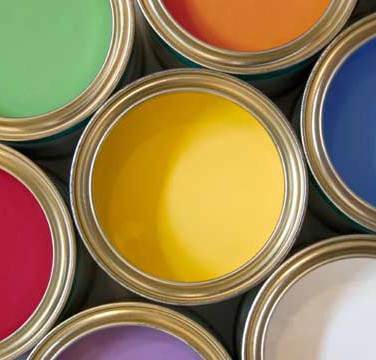Colour Advice
KNB0027
Users are advised that the actual paint colour from the container might not be identical to that shown on shade cards, brochures or in photographs. The differences can be caused by a number of factors that will result in colour variations, these being different substrate, different level of gloss which will affect the perceived colour and the level of lighting.

11/08/2009 14:46:12
General
Users are advised that the actual paint colour from the container might not be identical to that shown on shade cards, brochures or in photographs. The differences can be caused by a number of factors that will result in colour variations, these being different substrate, different level of gloss which will affect the perceived colour and the level of lighting.Uniform colour
A major problem is that you start painting an area and run out of paint, buy more and then notice the two colours are not exactly the same. This sheet gives some advice and steps to take to avoid this happening. It also includes some information as to why different containers of what is the ‘same’ colour might look different when applied.How much paint?
To minimise problems of having too little or too much paint it is important to calculate as best you can how much paint you will need.Industrial
Contact HMG Technical for information on coverage ratesDecorative
Measure the wall lengths, wall heights (and window and door openings) or size of door/window, length of skirting or drainpipes etc. Then calculate the volume of paint required by going to one of the following websites:www.dulux.co.uk/advice/paint_calculator/index.jsp
or
www.bbc.co.uk/homes/diy/paintcalculator.shtml
Remember paint only comes in fixed quantities e.g. 5 litres, 2.5 litres, 1 litre etc. Do NOT use small colour sample pots to make up quantities.
In-store tinted paint and ready mixed paints
Do not use both ready mixed paints (those already in container with specified colour) with in-store tinted paints (paints prepared in store using base and tinters). This is because there is always a tolerance in producing any colour and it is likely that when produced in a manufacturing plant it will differ to that made up in a store.If a tinting machine is used the paint from one mix will probably not be the same as the next one and if different machines are used then they will probably be different, therefore mix enough for the whole job at once.
Note: Different manufacturers must be avoided as again there is a tolerance for any given colour and it is likely that their colours could be slightly different even if supposedly the same.
General
Double check that the paint is correct colour before you start.Read the instructions on the container carefully.
Mix thoroughly before using – unless the instructions on the container tell you not to stir.
Store paint in closed upright containers and avoid extreme heat or frosts, keep the container dry.
More than one container – if the job requires more than one container then:
- Ensure all containers are of the same batch number, [there should be a reference number on the label indicating the batch, this should be different to any colour reference number].
- If different batch numbers have to be used then start a different batch in a corner to make any change less obvious.
- Avoid using different batches/containers where they will be noticeable.
For small areas such as doors or windows always use paint from only one container.
When touching up try and use the original paint whenever possible. Hence it is wise to try and keep a small quantity of the original paint.
Colour
Colour is a function of light and the perceived colour can depend on the substrate, the thickness of the paint, angle of viewing etc. The method of application can also affect the observed colour, paint applied by brush can look to be a different colour to paint applied by roller.Additionally the colour seen in daylight can differ to that seen in artificial light (this is known as metamerism). Therefore it is important that the colour is checked in the normal lighting conditions that will prevail for the particular coated substrate. For these reasons ‘touch ups’ should always use the original can of paint.
Any colour differences will be most noticeable with high sheen (high gloss) deeper shades, and therefore touch ups could result in the need to completely repaint the area and not just touch it up.